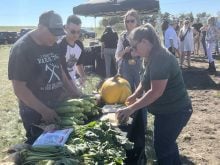A Saskatchewan farmer with an interest in experimentation is testing how a host of crops can be seeded with the same implement.
Keith Bacon, who farms six kilometres north of Ogema in south-central Saskatchewan, is testing 24 crops, all seeded with a John Deere 9350 hoe drill.
Garry Noble, a Saskatchewan Agriculture extension agrologist at Assiniboia, said crop diversification
doesn’t necessarily mean more equipment.
“There’s a perception on the part of many producers that specialized equipment is needed to seed any crops other than wheat. But we carried out all the seeding on these plots with a common implement,” said Noble.
Read Also

Canada’s plant hardiness zones receive update
The latest update to Canada’s plant hardiness zones and plant hardiness maps was released this summer.
One of the crops being tested is a short-season corn.
Because of uncertainty about the seeding rate for the corn, three settings for wheat were used, said Noble. The two-bushel-per-acre setting appears to be the most desirable at this time.
“It’s interesting to play with the seeding rates and also to see how this corn variety, Canamaize, is doing with this year’s low heat units,” he said.
Bacon said he suggested the test plots because, historically, this is wheat, durum and barley country. He farms, along with his family, 24 quarters and custom farms three quarters.
“But, by the late 1980s, I was going broke so, in the early ’90s, I started some mustard, then lentils and canola. Now I seed 50 to 60 percent mustard and lentils, and they’ve done very well for me.
“But I’ve always been interested in corn, so I wanted to know how it would do around here. I also find it interesting to see the differences in crops when they’re growing side by side. I think others do too, as I’ve seen people down on their hands and knees looking at the plots.”
The test plots contain seven oilseed varieties, seven pulse varieties, nine types of cereal crops and the corn. One of the more interesting pulses is AC Green Fix, a chickling vetch that fixes nitrogen in the soil.
“Chickling vetch is a green manure often used by organic farmers. It does a tremendous job of fixing nitrogen, and I think we’re going to see more and more producers using it,” said Noble.
The chickling vetch and other seeds were donated by neighboring farmers or obtained by Noble from various seed companies. Neighbors also helped Bacon and Noble with the seeding on land that Bacon rents. This land was chosen because it is beside a road with heavy traffic.
“Test plots are only valuable if they are visible. They are open 24 hours a day, seven days a week so, if producers see them, they can visit at their convenience. In a high-profile location, they may even see it every day, watch the progress and draw their own conclusions about the various crops. When you see different crops being grown in the district the following year, you know it’s done its job,” said Noble.














